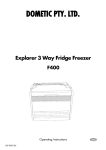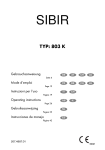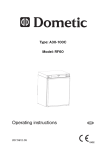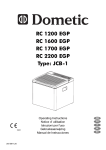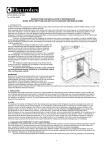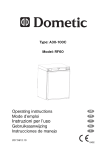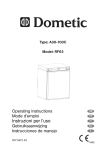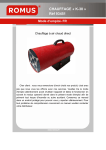Download Dometic F400 Operating instructions
Transcript
FREEZER/REFRIGERATOR F400 0402 GB Operating Instructions 207.5082.05 IE Please read these operating instructions carefully before putting the refrigeration unit into operation. If you later sell or dispose of it, please ensure that the new owner receives these operating instructions. Thank you for choosing our appliance. We are sure it will provide you with trouble-free use. In the following, we would like to familiarise you with some symbols, which we bring to your attention to ensure the safe and efficient operation of the appliance: source of danger, in event of improper operation suggested useful tips to read information concerning environmental protection TheFreezer / Refrigerator you have purchased is designed for operation from electrical mains, from a vehicle battery or from bottled (LP) gas. It can be used to transport frozen food or ice creme or as a normal refrigerator, depending on the settings (see the relevant capitels). Attention! Your portable Freezer/Refrigerator - in gas operation - must only be used in a wellventilated place, where it is protected from rain or water splashes. In electrical operation, the appliance can be used in an enclosed area. However the appliance must still be protected from moisture. In this appliance the storage of any toxic or explosive substance is forbidden! Attention! It is important in the interests of efficiency, to give the back of the unit as much ventilation as possible to allow the heat to escape. The hottest spot is in the vicinity of the burner, and particularly when operating on gas, it is essential that this place be kept clear of any obstruction or flammable materials (e.g. grass or plastic ground sheets that can burn). In electrical operation, the appliance can be used in an enclosed area. However the appliance must still be protected from moisture. 2 CONTENT S 1. 2. 3. 4. 5. 6. 7. 8. 9. 10. 11. Unpacking View of the appliance Cleaning Positioning the appliance Using the appliance 5.1. From electrical mains 5.2. From vehicle battery 5.3. From bottled gas Useful suggestions Defrosting, cleaning and maintenance Customer service Putting into operation, technical data 9.1. Connecting to electrical mains 9.2. Connecting to vehicle battery 9.3. Connecting to as cylinder 9.4. Connection of gas supply Environmental protection information Recycling 3 1. Unpacking After removal from the cardboard packaging, make sure the appliance is not damaged. If you find damage to the appliance resulting from transport, report it immediately to the transportation firm. 2. View of the appliance Figure 1. 4 1. insulated casing 3. control panel 2. insulated lid 4. rear cover 3. Cleaning Clean both the inside and outside of the appliance before putting it into use. To do so, use a soft towel, lukewarm water and a non-abrasive detergent. Ensure water does not enter the rear cover grille or the control elements. Afterwards, wipe the appliance with a clean towel and cleanwater, and then wipe it dry. To avoid damage, do not use soap, soda or abrasive cleaners. 4. Positioning the appliance During the refrigeration process, the appliance gives off heat from the condenser (under the upper part of the rear cover) into the surrounding air. The more ventilated the condenser is, the more effective the refrigeration will be. The other condition for satisfactory operation is that the appliance stands on a flat surface. This is best seen by placing a glass of water on top of the appliance. It is important that the appliance is not directly exposed to radiated heat (sunlight, radiator, near an oven, etc.). In gas operation following clearances should be kept from the walls or other materials: from the back side of the appliance minimum 10cms, from both sidewalls 4cms each, from the top of the appliance minimum 30 cms, from the bottom minimum 5cms. In the immediate vicinity of the appliance within the specified distances no inflammable matters (paper, wood, grass, textile etc.) should be met with. 5. Using the appliance The cable for mains connection, the 12V connecting cable and the connector for the gas hook-up are located on the rear cover of the Freezer / Refrigerator (Figure 2). 5.1. Operating from electrical mains Make sure the voltage shown on the data plate of the appliance matches that of the mains voltage to which you wish to connect the appliance. Pull out the mains connecting cable and connect it to a receptacle earthed socket for connection. When connecting the appliance for the first time, set the thermostat to maximum; then, after about five hours, set it back towards minimum according to your need of cooling. If you want to use the box as a freezer (-12°C) then leave the thermostat setting on the maximum, during the whole operation. NB: Plug is provided according to specific regulations in each country and may be different to that shown. Figure 2 5 5.2. Operating from 12 Volt vehicle battery Make sure the voltage shown on the data plate of the appliance matches the voltage of the vehicle battery (12V). In 12V operation, the appliance runs continuously without temperature control. The appliance is supplied with a matching pair of 12 Volt MALE + FEMALE plugs (see 9,2 connection to vehicle power source). For 12V operation, make sure, if the engine is not running, that the plug must be disconnected (see fig. 7). Otherwise, the appliance will discharge the vehicle battery when in operation. 5.3. Figure 3 Operating from bottled gas Connection to the gas cylinder is described in sections 9.3. and 9.4. After opening the valve of the gas cylinder and checking for gas leaks turn thermostat to maximum position (Figure 4), press down the gas safety valve hold it down for about 10 seconds and then, press the piezo-ignition button (marked with a star) several times in quick succession. If the flame does not ignite, repeat the process. (Air in the appliance gas line prior to connection to the gas cylinder must be purged. Only then can the gas be lit.) Ignition of the flame can be verified through the flameview opening (Figure 5). After you have the flame alight keep the safety gas valve pressed down for a further 10 seconds. The thermostat should be set to maximum to get the freezer function (-12°C). To use the cooling function the thermostat should be set towards minimum, depending on the ambient temperature, to avoid freezing of the goods. Figure 4. To stop the gas operation the valve of the gas cylinder (or the pressure regulator) is the close. Figure 5. 6 6. Useful suggestions When setting out on a trip, run the appliance on 230 V (in thermostat setting between min and max for cooling and "max" for freezing) for 24 hours prior to departure. Place food in a precooled condition into the appliance. Frost forms on the evaporator panel when in operation. When opening the lid or putting in food, some of this frost melts and collects in the form of water on the bottom of the appliance. Wipe the water off occasionally using a sponge. Avoid putting foods with fragile packaging (such as glass) into the refrigeration unit. Movements and shaking of the unit may cause these items to break. Once the Freezer/Refrigerator is in its permanent position, make sure foods do not come into contact with the evaporator panel, as this can cause freezer-burn to the foods. 7. Defrosting, cleaning and maintenance For defrosting, always unplug the appliance from an electrical power source to avoid the risk of shock. Make sure no other power source is connected (gas or 12V). Remove food from the refrigeration unit and leave the lid open. Depending on the temperature, frost melts in a short time from the evaporator panel, with water collecting at the bottom of the appliance. Wipe it off using a towel. Afterwards, clean the appliance by following the instructions in section 3. Leave the lid ajar to prevent any odours from forming. The appliance does not require any further maintenance. 7 8. Customer service 9.1 Before notifying customer service, please check the following: Are location and ventilation satisfactory? Is the appliance level? Is there a current in the wall socket and is the connection suitable for the appliance? Is the mains power cable damaged? For mains operation, is the electric thermostat swiched on? For gas operation, was the safety valve knob pressed down long enough? Is the thermostat knob set towards the maximum position? Is the gas cylinder or the pressure regulator valve open? Is there any gas in the cylinder? (If by shaking, no liquid movement can be detected, then the cylinder is empty.) Connecting to electrical mains Make sure no other energy source is connected (gas, 12V). The appliance may only be operated from nominal voltage mains as shown on the data plate. The appliance mains plug may be connected to a mains socket earthed in accordance with regulations. Any electrical work required to install this appliance should be carried out by a qualified electrician or competent person. The manufacturer declines any liability should these safety measures not be observed. Electrical Requirements Before switching on, make sure the electricity supply voltage is the same as that indicated on the appliance rating plate. Only for UK: Was warm food placed in the unit? The appliance is supplied with a 3 amp plug fitted. In the event of having to change the fuse in the plug supplied, a 3 amp ASTA approved (BS 1362) fuse must be used. Should the plug need to be replaced for any reason, the wires in the mains lead are coloured in accordance with the following code: Was a large quantity of food put in at one time? Green and Yellow: Earth Blue: Neutral Brown: Live Are by any chance two different power sources connected (such as gas or electricity)? If after checking the above, the appliance still does not operate properly, contact customer service. When reporting the problem, state the type of problem, the type of appliance, and the product number and serial number from the data plate. We assume the warranty in accordance with our warranty assumptions for the appliance. 9. Putting into operation You must, in all instances, operate the appliance from a single energy source only. Connecting several energy sources at the same time will cause failure of the appliance. Technical data: Model Type Gross volume Mains operation Input Energy consumption Battery operation Input Energy consumption Gas pressure (p) Gas classification Jet size Climate class Refrigerant F 400 JCB 3 39 litre 220-240V (AC) 120W 2.1 kWh/24h 12V (DC) 120W 240Ah/24h 28-30/37 mbar I3+ 26 N 550g NH3 + H2O 8 The wire coloured green and yellow must be connected to the terminal marked with the letter E or by the earth symbol or coloured green and yellow. The wire coloured blue must be connected to the terminal N or coloured black. The wire coloured brown must be connected to the terminal marked L or coloured red. Upon completion there must be no cut, or stray strands of wire present and the cord clamp must be secure over the outer sheath. 9.2 CONNECTING TO VEHICLE BATTERY Make sure no other energy source is connected (gas, 230V). The 12V female socket is on the backwall of the appliance, while the suitable male plug with a 2,5m long wire is an accessory supplied with your new appliance. Make the connection to 12 volt vehicle battery by a professional vehicle service the following way: Figure 6. The free end of the cable must be connected to positive and negative pole of the battery. Attention: connection to the positive pole may only be made through a 16A fuse! One possible way of the connecting can be seen (on figure 6.) A - fuse holder with 16A fuse B - wire ties C - positive battery cable If the 2,5m long cable proves to be short, up to 4m length 2,5mm2 ;while up to 6m length 4,0mm2 sectioned cable must be used. Pay attention to the voltage values noted on the rating label and on a label placed below the female socket! The 12V operation is turned on by connecting the plug and cut off by disconnecting the plug. Push the fixing tab with a screw-driver as can be seen (in figure 7). After that the plug can be disconnected. Figure 7. 9.3 Connecting to gas cylinder Make sure no other energy source is connected (230V, 12V). The unit must not be connected to town or natural gas pipelines. It is only suitable for use with propane/butane gas (e.g. Calor Gas, Camping Gaz, Caravangas, etc.). The freezer / refrigerator is equipped for a specific gas-pressure, corresponding to the standard pressure of the country in which it is sold. The rating-plate states the pressure that is correct. It is important that a non-adjustable pressure-regulator is used to reduce the pressure in the gas cylinder to the operating pressure specified on the rating-plate. No other pressure may be used. Needle valve-operated gas control taps are NOT suitable for use with this appliance and must not be used as a substitute for a pressure regulator. 9 9.4 Connection of gas supply (The following instructions refer in the main to coolers manufactured in the United Kingdom. For other countries please refer to your supplier.) Always connect in the following sequence: GAS BOTTLE → PRESSURE-REGULATOR → → APPLIANCE. To connect the appliance to the pressure-regulator an APPROVED GAS TUBING should be used. This should be minimum in length - have an inside dimension of 8mm and be marked BS3212/2/8. The pressure-regulator must be compatible for Butane 11 in (28 mbar) or for Propane (37 mbar). To connect the pressure-regulator to the gas bottle, the valve of the gas bottle must be closed. After connecting the pressure regulator to the bottle by screwing, connect the two ends of the tubing to the nipples and secure them with the two hose clipse. (Figure 9). The gas bottle (Butane, blue bottle) may only be used in an upright position and particular care must be taken every time the appliance is connected to the gas bottle to ensure that there are no leaks, that the tubing (rubber hose) is not under tension or kinked, and that it is not in contact with hot surfaces. The tubing and the gas bottle should always be located in positions where they will not be tripped over or otherwise inadvertently disturbed. Before attempting to light the burner, every time after connection, turn on the gas at the bottle and check the gas connections for leaks by applying a soap and water solution over them and watching for bubbles, which would indicate a leak. After testing dry off traces of detergent. When fitting the connection to the gas inlet of the appliance (Figure 8), hold the counterpart to avoid straining and possibly damaging. Figure 8. For your safety: Do not check for leaks with a naked flame! 10 Figure 9. Do not smoke while checking for leaks! 10. Environmental protection information The appliance does not contain any CFCs/HCFCs. Ammonia (natural hydrogen and nitrogen compound) is used as a refrigerating agent in the refrigeration unit. The ozone-friendly cyclopentane is activated as a motive agent for the PU foam insulation. Sodium chromate is used for corrosion protection (less than 2 weight % of the coolant). 11. Recycling After unpacking the appliance, the packing materials should be delivered to a local collection site. At the end of its useful lifetime, the appliance should be delivered to a specialised collection and reprocessing firm, which reclaims the usable materials. The rest is properly destroyed. This appliance complies with the following EEC directives: LVD-Directive 73/23/EEC with amendment 90/683/EEC EMC-Directive 89/336/EEC Gas-Directive 90/396/EEC. 11 Printed by Xerox Hungary Ltd. Rev.:2003. 12. 17.












